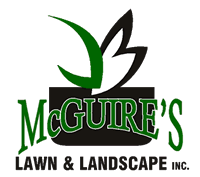McGuire’s Lawn & Hardscape – Helpful Tips
McGuire’s Lawn and Hardscape has been servicing Nashville, Brentwood, Franklin, Bellevue, Belle Meade and Green Hills areas since 1994.
Professional Landscaping
Professional Landscaping adds beauty and value to your home…
· Increases worth of your home by 15%
· Builds “curb appeal”
· Keeps temperatures down to reduce heating and cooling costs
· Screens out sights and sounds
· Improves environment by cleaning the air
Proper Mowing
Proper mowing, along with proper watering, can be the most critical factor in the appearance of a lawn. Good mowing techniques not only enhance the appearance of the lawn, but also increases the turfgrass vigor.
Mowing Height
Turfgrass stressed by mowing too low is more prone to disease, weed invasion, drought and traffic stress. Removal of most of the leaf blade limits food production. Limited food production decreases root, thizome, and stolon growth. Plants with limited food production and a limited root system will not have vigorous growth. A vigorous, dense turfgrass area is one of the best defenses against weed invasion. Weak grass plants with a limited root system are more prone to drought damage. It is particularly important to mow high during dry weather. Mowing height varies for different turfgrass species:
Many turfgrasses such as Kentucky bluegrass should be cut at 2 1/2 to 3 inches.
Bentgrass and bermuda grass should be cut at 1 to 1 1/2 inches.
Determine the type of turfgrass in a lawn before recommending mowing heights.
Mowing Frequency
The second critical factor is mowing the lawn on a frequent basis.
The grass should be mowed so that no more than 1/3 of the leaf blade is removed.
If the desired height is 3″, mow the grass when it has grown to 4″.
Mowing frequency will change throughout the year with different weather patterns.
Cool season grasses such as Kentucky bluegrass may require mowing twice a week in the spring, but only every 7-10 days in the summer.
Warm season grasses such as Bermuda grass may need more frequent mowing in the summer than in the fall or spring.
Scalping
When a lawn is allowed to grow too high and then mown too low, excess leaf blade tissue is removed. Such “scalping” of the lawn can cause severe visual damage. More importantly, scalping shocks the grass plants and growth slows or stops, limiting the vigor of the turf. A scalped lawn may dry out quickly from drought, or may develop unusual weed and disease problems.
